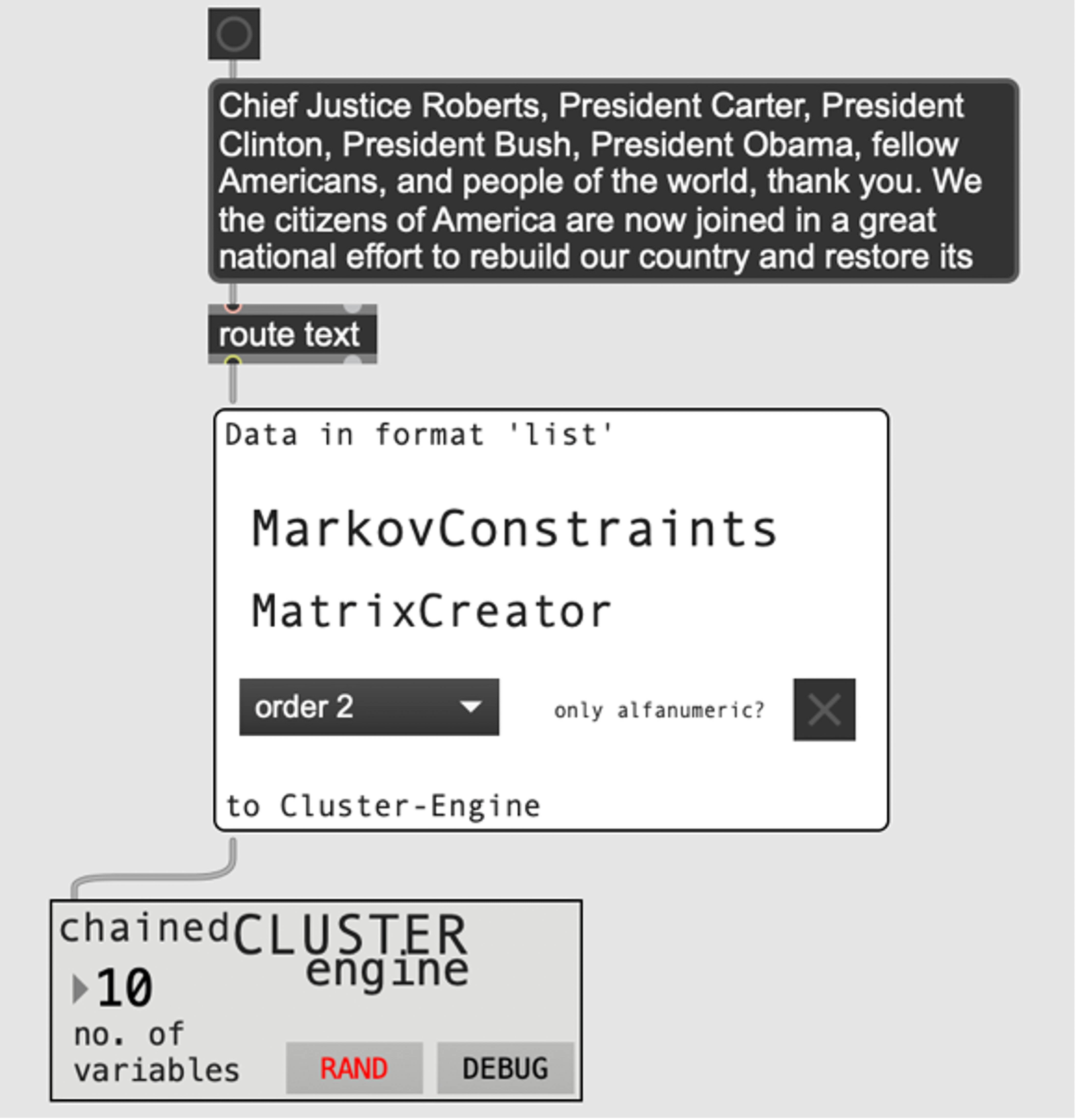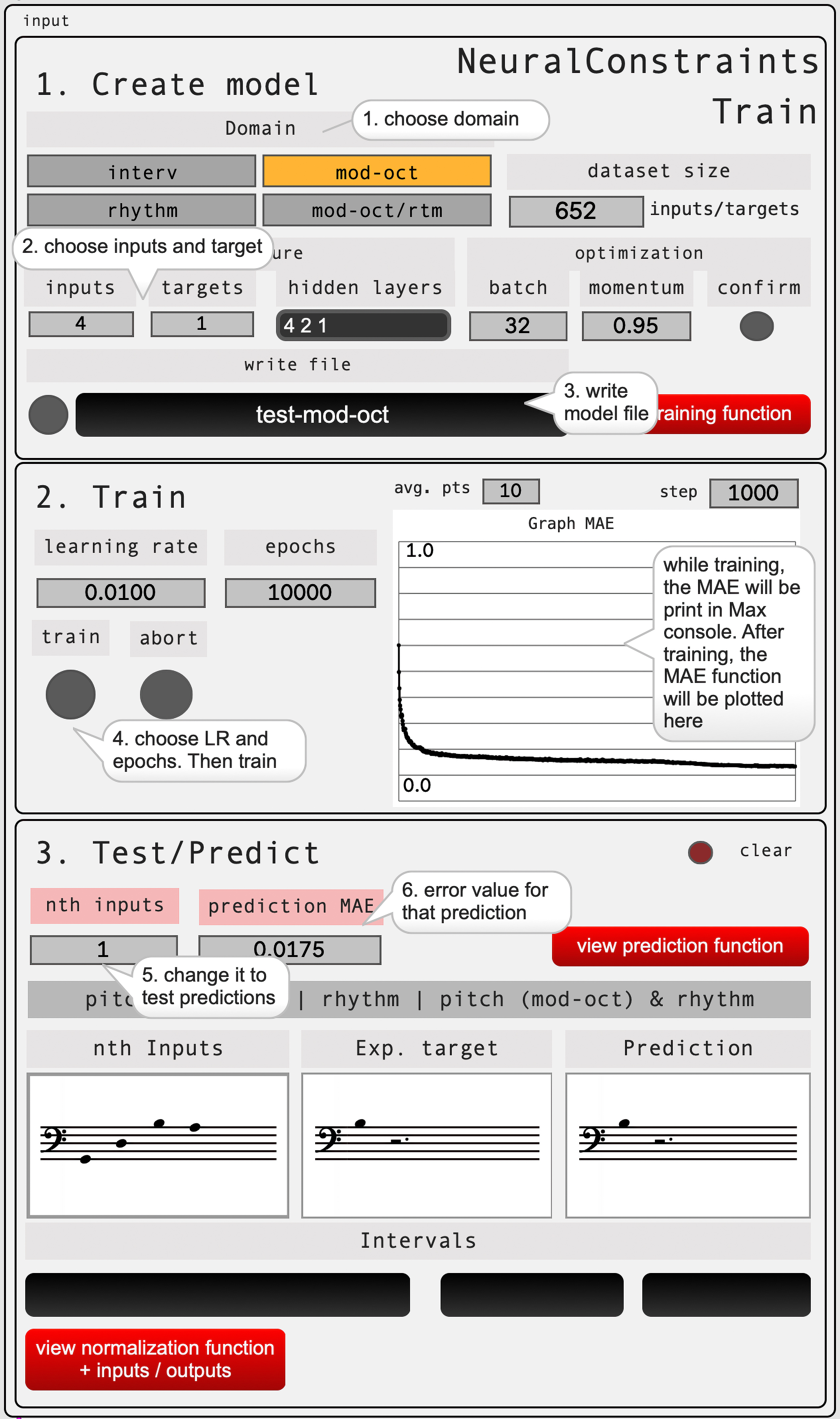Conclusions?
Chapter Overview
- Contributions
- nPVIconstraints
- MarkovConstraints
- NeuralConstraints
- fNIRS_to_live
- Future Developments
- Conclusions
- A Neurocognitive Perspective
- Composition and Institutionalization
- The Borders of Formalization
- AI: Enemy or Ally?
- Perspectives for the Future
Contributions
Part of the contribution to the field of this project is related to the development of new technology in the form of software. During my research position, I worked on the development of several CAC libraries and functions. Initially, these came as tools to pursue certain creative inquiries, and their use and implementation are at the core of all the works in the Artistic Result. As they turned out to be quite handy and user-friendly, I decided to make them available for other practitioners. Essentially, all of these tools function as add-ons to the CAC libraries Cluster-Engine and PWConstraints.
nPVIConstraints
The abstraction nPVIConstraints –a prototype of it was used in the piece Versificator – Render 3– calculates the nPVI index * I discussed the nPVI index in more detail in the chapter ‘The Cognitivist Paradigm’, particularly its use within the Vowel Chorale generative module in the piece Versificator – Render 3. of a list of numbers. It is a useful tool to explore the idea of contrastiveness in composition, initially related to durations but easily translatable to any musical parameter. The nPVIConstraints abstraction allows the use of the nPVI index as a constraint rule for PMC or Cluster-Engine It is possible to choose a desired value for the index or a range of values.


MarkovConstraints
The module MarkovConstraints was used extensively in the piece Elevator Pitch. It consists of a variable-order Markov chain that functions as a constraint rule. MarkovConstraints is, at its core, a refinement of a Markov rule written by Örjan Sandred. *This original rule can be found in the documentation of the library Cluster-Engine in MOZ’Lib, in “demos,” “example [c].” My refinement of this rule consisted of making it a variable-order rule (originally, it was an order 1 rule) and adding some basic functions to deal with text, such as sieves and the option to use only alphanumeric characters. It consists of two abstractions: MarkovConstraints-Matrix and MarkovConstraints-Rule. MarkovConstraints-Matrix takes as input a list and creates a Markovian transition matrix from it. Users can choose the Markov order between 2nd and 4th as well as to apply an alphanumeric filter for characters. The transition table is output as a global variable that Cluster-Engine or PMC will access during the search process.

The module MarkovConstraints-Rule, when attached to a Cluster-Engine one-engine accessor, checks every possible combination of elements in the domain and returns only those that exist within the Markov transition matrix stored in the engine. The selected order should be equivalent to the order choice for the matrix (consider that a rule for a 4th order will take considerably more computational resources than an 2nd or 3rd orders).

The rule can be efficiently chained to other constraint rules. Therefore, the Markovian generative process –otherwise largely dependent on probabilities– becomes feasible to be steered towards desired outcomes in which both scopes –global and local– can be more effectively controlled.
NeuralConstraints
Within this project, I worked in collaboration with Örjan Sandred and Julien Vincenot on the development of NeuralConstraints (NC), a suite of CAC tools that integrates a feedforward neural network as a rule within a constraint-based compositional framework. I used these tools extensively in the piece Oscillations (iii). NC provides a user-friendly interface for exploring symbolic neural generation and constraint algorithms, providing a higher level of compositional control compared to conventional neural generative processes. * A fully-detailed technical discussion about NeuralConstraints can be found in Vassallo, Juan S. et al. "Neuralconstraints: Integrating a Neural Generative Model with Constraint-Based Composition." Frontiers in Computer Science, vol. 7, 2025, https://doi.org/10.3389/fcomp.2025.1543074
NC combines the generative abilities of neural networks trained on symbolic data with a rule-based compositional system supported by an advanced and backtracking constraint algorithm. This approach allows the generation of a musical sequence that follows a rule guided by neural network predictions while simultaneously being constrained by additional rules. For example, it is possible to train a neural network on a set of pitches from a corpus of melodies and use it as a heuristic rule that will steer the solution toward melodic patterns based on these melodies. In addition, this rule can be combined with other rules, such as desired or allowed notes at certain time points, allowed interval movements, patterns of repetition or non-repetition, and so on. The constraint solver provides the logical framework to support these more structural aspects of music, while the neural network offers an inferential method where learned musical examples can influence the solution.
Traditional feedforward neural networks tend to produce deterministic results, which limits their adaptability in dynamic compositional contexts. One key innovation of NC is its use of neural networks as heuristic guides rather than as deterministic predictors. To address this limitation, we utilized Mean Absolute Error (MAE)*Mean Absolute Error (MAE) is a metric used in ML in regard to predictive models to measure the average magnitude of errors between predicted and actual values in a dataset. values as heuristic weights, ranking solutions by their relative fitness instead of enforcing a single “correct” answer. This approach introduced flexibility, allowing the neural network to influence the outcome in interaction with other compositional rules, which can be either strict or heuristic.

One limitation of NC is that, as of now, it can only learn short-term musical patterns. This is an important challenge, as a more advanced approach would demand modeling both long- and short-term structures. Although constraint rules can help manage long-term aspects, the future development of NC might be tied to the implementation of more complex LISP-based neural networks to address long-term musical structures.
Additionally, future improvements in the library aim to incorporate a metric domain to improve melodic pattern recognition based on metric recurrences. As of now, the “Multidomains” feature of Cluster-Engine offers promise for expanding constraint rules to include parameters like dynamics and articulations, although such an improvement would potentially demand significantly more computational resources. Another research thread consists of using NC as a tool for classifying inputs rather than predicting continuations. Lastly, it is desirable to explore the system’s potential for real-time applications, like live music generation or interactive installations.
fNIRS_to_Live
The Max4Live device fNIRS_to_Live directly communicates between an fNIRS helmet and Ableton Live, enabling real-time work with spectroscopic brain readings as a source for live artistic experimentation, both in sound and video.
The fNIRS helmet is capable of streaming data in real time, and this data can be transmitted across the local network via the LabStreamingLayer (LSL) * "LabStreamingLayer [open source software package]," 2023, https://github.com/sccn/labstreaminglayer. protocol. LSL is an open-source protocol widely used in research to ensure precise synchronization of data streams across different devices, and numerous manufacturers like NIRx support it. A specialized script was developed to convert the LSL stream into an Open Sound Control (OSC) stream in real time. As the NIRSport2 includes Wi-Fi recording capabilities, it, along with two NIRSport2 devices, the Aurora recording laptop, and the Max laptop, can all connect to the same Wi-Fi hotspot, facilitating seamless wireless communication in real-time. The first version of the communication protocol script between Aurora fNIRS and Max was written in Python 3 by Ryan McCardle (Senior Engineer in the Department of Biological and Medical Psychology of the University of Bergen). The protocol employs the pylsl * "pylsl [open source software package]," 2015, https://github.com/chkothe/pylsl. package to handle the LSL packets and the python-osc * "python-osc [open source software package]," 2023, https://github.com/attwad/python-osc. package to dispatch the OSC packets. This script primarily filters out the bulk of the data, leaving only the HbO (oxyhemoglobin) levels, and sends out via OSC forty-two individual streams –one for each of the forty-two channels recorded by the fNIRS helmet.
Building upon Ryan’s communication protocol, I wrote an interface in Ableton Live that receives the data for all of the channels, and it can then be utilized for parametrical control within Ableton Live. The fNIRS_to_Live device is capable of receiving a stream of forty-two channels as OSC messages via a UDP receiver function. From these forty-two, it is possible to choose those to be shown on the graphic viewer and map these lines as control signals for diverse Live –and external– audio and MIDI effects via the mapping function.
In addition, the device includes a calibration function that learns the maximum and minimum values of each channel over a desired time. Since the scales for each channel might vary significantly, the calibration smoothens the lines and contributes to an overall homogeneity of the mappings. Additionally, the device allows for different configurations for active channels, ranging from 1 to 48 simultaneously active channels, saving and recalling presets, and reading preexisting data as text files. In a subsequent refinement, I added a filter function, and a speed limit for the data reception, which yields a smoother stream of numbers. This can be adjusted dynamically.

Since fNIRS is an extremely expensive and sensitive medical technology, I don’t expect it to be extensively used for artistic purposes anytime soon. Nonetheless, while this technology becomes more available for artistic purposes, I believe that future work could be directed towards the use of measurements of higher cognitive functions to trigger artistic effects concurrently, * See for exampleYuksel et al., "Short BRAAHMS: A Novel Adaptive Musical Interface Based on Users' Cognitive State."; S. K. Ehrlich et al., "A closed-loop, music-based brain-computer interface for emotion mediation," PLoS One 14, no. 3 (2019), https://doi.org/10.1371/journal.pone.0213516. rather than the obvious use of readings of brain responses to low-level stimuli –such as the response of the auditory cortex to auditory stimuli. This, I believe, could be a potential research direction to follow.
Future Developments
Except for fNIRS_to_Live, in general, all my software developments within this project have been related to constraint satisfaction programming. In this line, an issue that I view as an important general aspect to consider for future research is using this framework for artistic endeavors in real time. * A great example of real-time usage of constraint programming is the work Sonic Trails by Örjan Sandred, a multimedia installation for three semi-transparent screens, two projectors, quadraphonic sound, and live electronic processing using constraint programming. It is possible to find documentation on this work on the author’s website, https://sandred.com/. I did not pursue this inquiry directly within this project, as all my implementations were meant to be used offline. However, I believe that this issue is something that remains to be addressed. Additionally, I see potential for future work in another scarcely investigated issue, that of the use of constraint satisfaction programming for directly synthesizing or processing sound. Even though the nature of constraint programming is symbolic, it might be possible to map some symbolic aspects of sound synthesis or digital signal processes for constrained programming in an interesting way. Maybe this idea could take the thread of previous work related to perceptually-informed composition by Sean Ferguson * Sean Ferguson and Richard Parncutt, "Composition 'in the flesh': Perceptually-informed harmonic syntax" (paper presented at the International Conference on Sound and Music Computing, Paris, 2004). or composition and notation of synthetic sounds by Johannes Kretz. * Johannes Kretz, "KLANGPILOT - a new interface for 'writing' (not only) synthetic sounds" (paper presented at the International Conference on Mathematics and Computing, 2011).